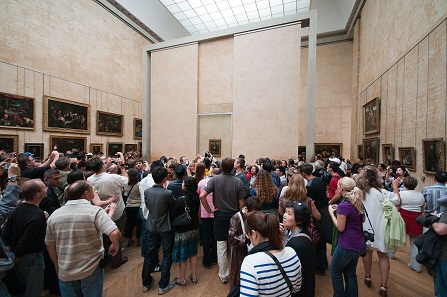by Ursula Kampmann
translated by Christina Schlögl
April 12, 2018 – The Louvre had 8.10 m. visitors in the year 2017. This amounts to more than 22,000 visitors per day. Assuming that most of them pay an entrance fee of 15 euros, one will quickly understand Sylvester Okwunodu Ogbechie’s desires. He is a professor for art and architecture at the University of California in Santa Barbara, who recently did not only ask for the return of important objects but also demanded reparation payments. After all, the western nations had made a lot of money by displaying African objects, he said. But he may have miscalculated! The museums might just present him with a long bill of state and private resources which were necessary to store the large stock of objects in depots and preserve them from harm.
The Mona Lisa at the Louvre. Photo: Pueri Jason Scott, cc-by 3.0.
Incidentally, even the Louvre cannot cover its expenses with an income from 8.10 m. visitors! It is both dependent on government funds and regular contributions by the private sector – or foreign states, as project Abu Dhabi has shown.
The Top Ten Museums in the World
| 1 | Musée du Louvre | F-Paris | 8.10 m. |
| 2 | National Museum of China | CHN-Beijing | 8.06 m. |
| 3 | Metropolitan Museum of Art | USA-New York | 6.69 m. |
| 4 | Musei Vaticani | I-Rom | 6.42 m. |
| 5 | British Museum | GB-London | 5.90 m. |
| 6 | Tate Modern | GB-London | 5.65 m. |
| 7 | National Gallery of Art | USA-Washington | 5.23 m. |
| 8 | National Gallery | GB-London | 5.22 m. |
| 9 | National Palace Museum | TWN-Taipeh | 4.43 m. |
| 10 | Eremitage | RUS-St. Petersburg | 4.20 m. |
The ten most popular museums are all in large tourist centres of the world. They attract millions of visitors. But no culture temple can survive on local visitors alone.
China on its way to cultural nation No. 1
China’s cultural interest has grown enormously over the last decades and is now very strong, maybe stronger than in the Old World, which is shown by the fact that the National Museum of China, first opened in March 2011 as the world’s largest museum, is already on second place in the Top Ten with 8.06 m. The National Palace Museum in Taipei, which has the largest collection of Chinese artwork in the world, ranks in 9th place – before the Hermitage Museum with its 65,000 exhibits displayed in 350 exhibition rooms.
There is no room left for technical museums
If someone were to complain that the educational ideal of the past centuries is no longer valid, one would have to point out that there is not a single science museum or technical museum among the Top Ten. The top places are dominated by art galleries and museums with different areas all of which have significant art galleries, too.
Just to compare, the well-known Museum of Science and Industry in Chicago boasts with 1.4 m. visitors per year. About the same (1.45 m.) visited the Munich-based German museum.
Where were the most successful exhibitions?
Let’s take a look at the most successful exhibitions and where they are created. Tokyo made first place by far. Five events that happened in Tokyo were under the top 20. Exhibitions in Tokyo ranked 1, 3, 5, 11 and 16. The first place was an exhibition that only lasted two months with 22 sculptures of the famous Japanese sculptor Unkei (ca. 1150-1223), which attracted 11,268 per day.
One reason for this could be that “The Art Newspaper” calculated the places according to the average number of visitors per day. And these exhibitions were only open for two to three months, after all.
Consequently, place two for Paris is relative. Four of the most frequently visited exhibitions happened there. They mostly lasted for four months and had a higher overall number of visitors. The presentation of the Shchukin Collection for instance which could be seen at the Fondation Louis Vuitton for four months saw 1.2 m. visitors. During this time there was an average of “only” 8,926 people at the exhibition per day.
One might also be impressed by the fact that the Guggenheim Museum in Bilbao took four of the Top 20 places. It is thus the most successful museum in the area of exhibitions in the world.
If it’s older than the impressionists – forget it!
There are two other interesting details to be mentioned: Let us start with the fact that of the 10 most frequently visited museums in the world not a single one created an exhibition that made the Top 20. And the succeeding topics: Unkei and Bruegel were the only pre-impressionistic artists that could attract the masses. In other words: Modern art with a main focus on impressionism is most suitable for the masses.
It’s obvious that numismatic exhibitions cannot compete with that. But one might ask if we should actually be envious of these mass spectacles. What increase of knowledge will a person truly get from standing in line with thousands of other annoyed tourists to take a selfie in front of the Mona Lisa?
Can art really be measured in quantity? Should we do that? Or would that rob art of its liberty and enchain it commercially? Can there be art without commerce? And where does culture come to play? The kind of culture that once entailed the true contemplation of artworks instead of merely checking them off on one’s tourist agenda.
You can find the article of the Art Newspaper on the Top Ten of Museums and exhibitions here.
Here is an article for your museum director on how to increase their number of visitors dramatically.
And if he or she suggests hiring a DJ for exciting nights in the inner courtyard, please show them this article by the Independent on a Terracotta warriors’ thumb which was broken off during an “Ugly Sweater Party” at the Philadelphia museum – it caused some diplomatic displeasure.
Here you will find another, more harmless article on rethinking current titles. An info-graphic shows how titles have changed between 1997 and 2017.
And after getting inspired by the previous article, you can get informed on creating exhibitions that are suitable for the masses.
And the artist Gerhard Glück will show you how the Mona Lisa feels when faced with thousands of visitors.





